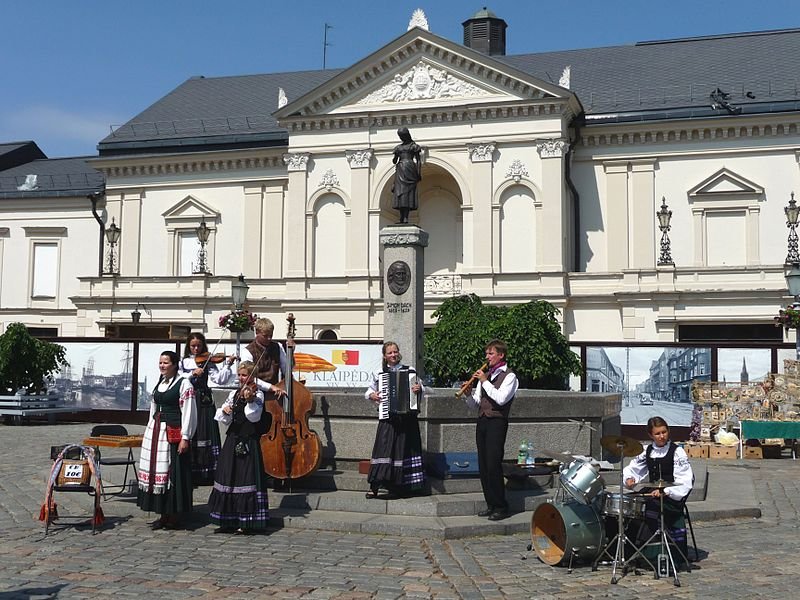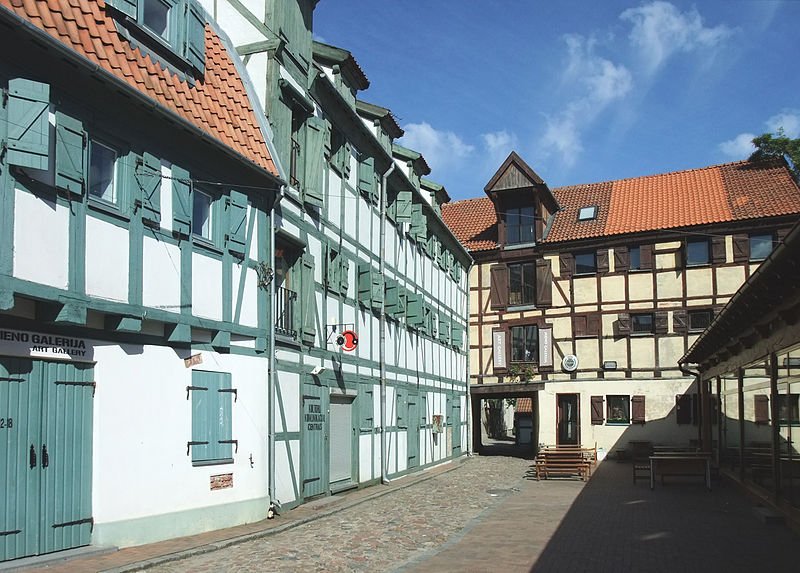 Folk group with the Ännchen of Tharau statue in Theater Square, Klaipėda
Folk group with the Ännchen of Tharau statue in Theater Square, KlaipėdaSource: https://commons.wikimedia.org/wiki/File:Klaipeda_-_Annchen_von_Tharau_with_Folklore_Group.jpg
Author: GraceKelly

Klaipėda (German: Memel) is the third largest city and only seaport of Lithuania. It is located at the mouth of the Nemunas River which empties into the Baltic Sea. The city covers 110 sq km (42.5 sq mi) and has a population of 161,000 people (2011 estimate).
Klaipėda experiences a mix of the oceanic and continental climates. Summers are warm while winters are mild to cold. Warmest month in Klaipėda is August, when the average high temperature rises to 20.1°C (68.2°F). Coldest month is January, when the average low temperature drops to -5.2°C (22.6°F). September is the wettest month, receiving 89 mm (3.5 in) of rain.
The area around Klaipėda has been settled by the 7th century AD. The Teutonic Knights from Lübeck built a fort here, known as Memel Castle, in 1252. German settlers from Holstein, Lübeck and Dortmund came and developed the area around the fort.
 Timber-framed houses in Klaipėda
Timber-framed houses in KlaipėdaSource: https://commons.wikimedia.org/wiki/File:Klaipeda-Stadtrundgang_02.jpg
Author: Nikater

Over the centuries, Memel became part of the Duchy of Prussia in 1525 and the Kingdom of Prussia in 1701. It was captured by Russia in the Seven Years' War in 1757. It returned to the Kingdom of Prussia in 1773, as part of the province of East Prussia. From the 18th until early 20th century, it prospered on trade dominated by the English. The city was a major wood manufacturing and timber exporting hub, with most of the timber heading for Great Britain.
When Germany was unified in 1871, Memel became the northernmost city of the German Empire. During this period, Memel's population grew rapidly, but due to political reasons, development could not keep apace, as more attention was paid to Königsberg, the provincial capital. The city did become the center of publication for books written in the Lithuanian language written using the Latin alphabet - such books are banned in the Russian Empire.
With the independence of Lithuania, the name Klaipėda was popularized over the name Memel, which was of German origin. It was known officially as Memel from 1252 until 1923, and again from 1939 until 1945, when the Nazis occupied it. Between 1923 and 1939, both names were officially recognized, but since 1945, the city has been known by its official Lithuanian name, Klaipėda.
Visiting Klaipėda
You can reach Klaipėda by ferry from Keil, Sassnitz and Karlshamm. There are also trains and buses from Vilnius.Places of Interest in Klaipėda
- Ännchen of Tharau
Statue in front of the Theater Square in the heart of Klaipėda's Old Town. The present statue was made in 1989 to replace the original made in 1912 but was mysteriously removed on the eve of the Second World War. - Blacksmiths' Museum
Museum celebrating the craftmanship of Lithuanian blacksmiths, whose tradition in cross-crafting has been recognized by UNESCO as a folk art. - Castle Museum
Museum housed in the remnant of Memel Castle. The castle itself was built in the 17th century, on the foundation of the original fortress built in 1252. - Clock Museum
Opened in 1984, this museum showcases various forms of clocks and includes sundials and sand clocks. - Lithuania Minor History Museum
This is the museum of East Prussia, which is known locally as Lithuania Minor. The area includes present-day Klaipėda as well as Kaliningrad in Russia. Housed in one of the loveliest buildings in Old Town, it displays maps, clothes, coins, and other items from the pre-World War II era. - Picture Gallery and Sculpture Park
Gallery named in honor of Pranas Domšaitis, the Lithuania-born artist who later settled in South Africa. The gallery displays his works as well as that of other 20th century Lithuanian artists. Behind the gallery is the Sculpture Park dedicated to author of the first book in Lithuanian, Martynas Mažvydas.
 Latest updates on Penang Travel Tips
Latest updates on Penang Travel Tips

Copyright © 2003-2025 Timothy Tye. All Rights Reserved.

 Go Back
Go Back